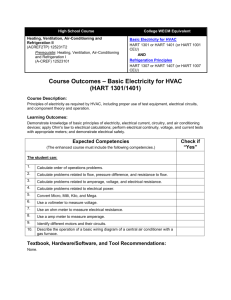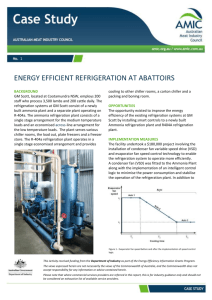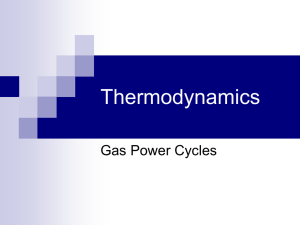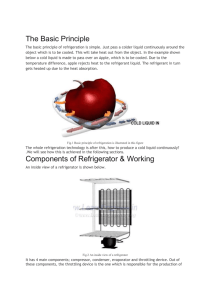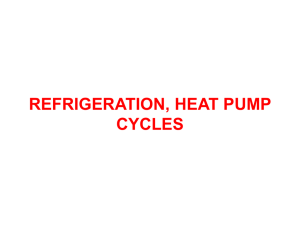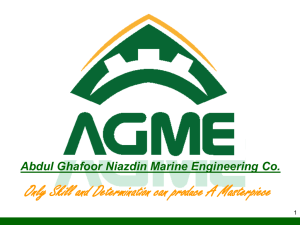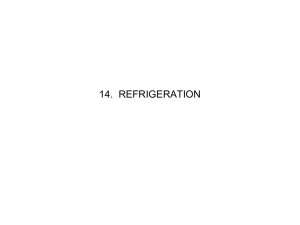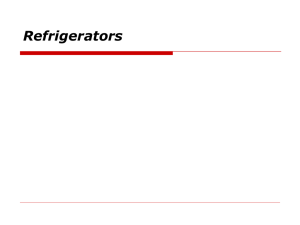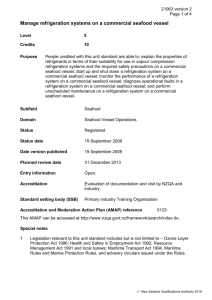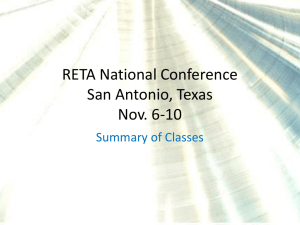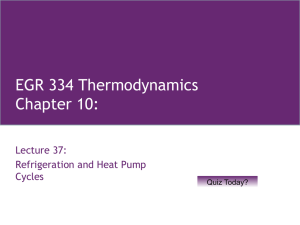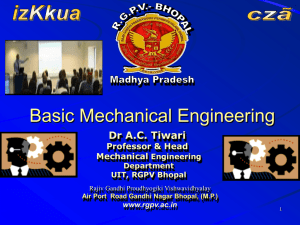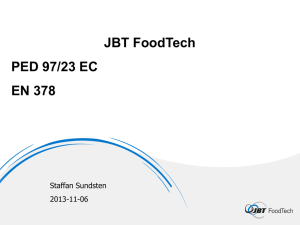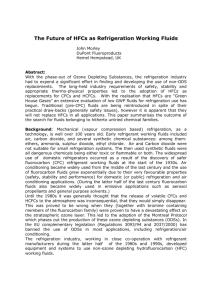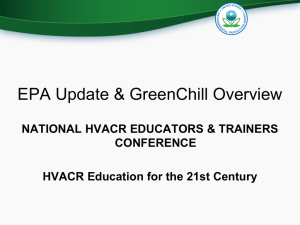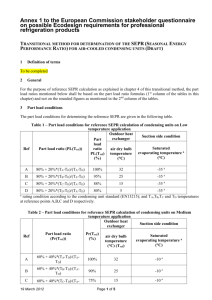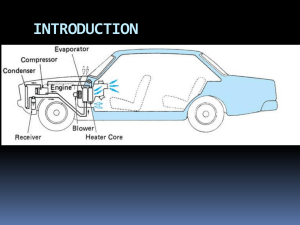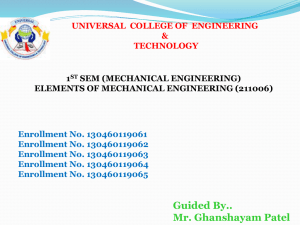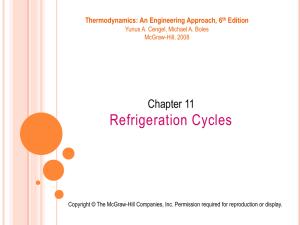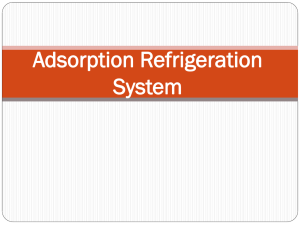Basic-concepts
advertisement
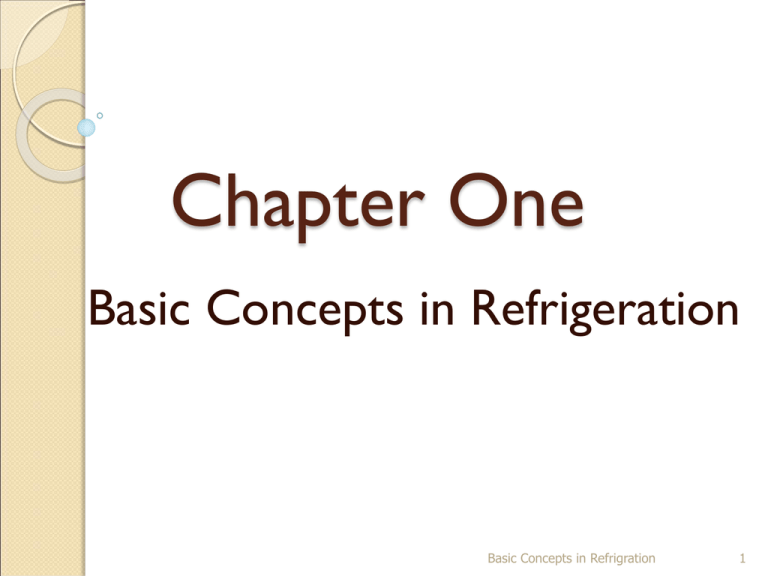
Chapter One Basic Concepts in Refrigeration Basic Concepts in Refrigration 1 Objective of the chapter To introduce students about the basics of refrigeration Basic Concepts in Refrigration 2 Introduction Refrigeration is concerned with the production of cool confinement absorbing heat from the space where cooling is required The branch of science which deals with the process of reducing and maintaining the temperature of a space or material below the temperature of the surrounding The heat is then rejected to some natural sink such as: The atmospheric air Surface water Any external body lower in temperature compared to the space Basic Concepts in Refrigration 3 Continued……… A refrigeration system is a combination of components, equipment and piping connected in a sequence to produce the refrigeration effect Refrigeration Cycle: when a refrigerant undergoes a series of processes like evaporation, compression, condensation, throttling and expansion, it is said to have undergone a refrigeration cycle Basic Concepts in Refrigration 4 Basic Concepts in Refrigration 5 Continued…… Refrigeration cycle are classified mainly in to the following : Vapor compression refrigeration cycle Vapor absorption refrigeration cycle Air refrigeration cycle and Steam- jet refrigeration cycle Basic Concepts in Refrigration 6 Principles of Refrigeration REFRIGERATION SYSTEM COMPONENTS The basic components of a refrigeration system are: - Evaporator - Compressor - Condenser - Expansion Valve - Refrigerant; to conduct the heat from the product Basic Concepts in Refrigration 7 Basic Concepts in Refrigration 8 Basic Concepts in Refrigration 9 Need for Refrigeration The growth of microorganisms is temperaturedependent, that growth declines as temperature falls, and that growth becomes very slow at temperatures below +10 °C Use of refrigeration to conserve foodstuffs and natural ice came into use for this purpose Basic Concepts in Refrigration 10 Application of Refrigeration Foodstuff production, conservation and preservation Chemical processing industry Industrial and comfort air conditioning plants Drying plants, etc Basic Concepts in Refrigration 11 Methods of Refrigeration There are different methods of refrigeration. Among them: Solution (dissolution of salts in water) and Change of Phase Are mostly used in the refrigeration processes Basic Concepts in Refrigration 12 Solution (dissolution of Salts in water) When certain salts such as NaCl or CaCl2 are dissolved in water, they absorb heat CaCl2 lowers the temperature of water up to -50oC while NaCl up to -20oC The salts used for refrigeration has to be regained by evaporating the solution The refrigeration produced is quite small compared to the large amount of energy required in salt regaining process Basic Concepts in Refrigration 13 Change of Phase If a substance such as ice is available, it is possible to get refrigeration due to the change of phase ◦ Solid change to liquid, the cooling produced is: Qs1=m1hsf Where m1 is the rate of fission of ice & h s f is the enthalpy of fission (340kj/kg) Basic Concepts in Refrigration 14 Continued……… ◦ Refrigeration can be produced by change of phase from solid to vapor-Sublimation. This occurs when the pressure of the system is lower than the triple point pressure Qc2=m2hsv Where h s v is the enthalpy of sublimation ◦ Solid carbon dioxide (dry ice) at one atmospheric pressure produces about 570kJ/Kg of refrigeration maintaining it self at a temperature of about -75 oC Basic Concepts in Refrigration 15 Continued……… Refrigeration can be created due to the phase transformation from liquid to vapor Qc3=m3 (hg-h f) =m3hfg Basic Concepts in Refrigration 16 Requirements of Refrigerant There are certain desirable characteristics which a fluid used as a refrigerant should posses: ◦ ◦ ◦ ◦ ◦ ◦ ◦ ◦ non-poisonous Non-explosive Non-corrosive Non-inflammable Leaks should be easily detected Leaks should be easy to locate Should operate under low pressure Stable gas Basic Concepts in Refrigration 17 Continued…….. ◦ Parts moving in the fluid should be easy to lubricate ◦ Non- toxic ◦ Well balanced enthalpy of evaporation per unit mass ◦ Small relative displacement to obtain a certain refrigerating effect ◦ A minimum difference between the vaporizing and condensing pressure is desirable The standard comparison of refrigerants as used in refrigeration industry is based on an evaporator temperature of -15oC and condensing temperature of 30oC Basic Concepts in Refrigration 18 Identification Refrigerant by Number Refrigerant No Name and chemical formula R-11 Trichloromonofluoromethane (CCl3F) R-12 Dichlorodifluoromethane (CCl2F2) R-22 Monochlorodifluoromethane (CHClF2) R-500 Mixture of 73.8% R-12 and 26.2% R-152a R-502 mixture of 48.8% R-22 and 51.2% R-115 R-717 Ammonia (NH3) R-134a Tetrafluoroethane (CH2FCF3) Formula generation C m H n F p Cl q Designated by R-(m-1)(n+1)(P) Basic Concepts in Refrigration 19 Classification of Refrigerants The National Refrigeration Safety Code, USA (NRSC) catalogues all the refrigerants into three groups. Some of these are: ◦ Group one – ( Safest of the refrigerants) R-113, R-11, R-21, R-114, R-12, R-30, R-22, R-744, R502, R-13, R-14, R-500, R-134a ◦ Group two- (Toxic and somewhat Inflammable Refrigerants) R-1130, R-611, R-160, R-764, R-40, R-717 ◦ Group Three- (inflammable Refrigerants) R-600, R-290, R-170, R-1150, R-50 Basic Concepts in Refrigration 20 Evaporator The purpose of the evaporator is to remove unwanted heat from the product Refrigerant contained within the evaporator is boiling at a low-pressure. The level of this pressure is determined by two factors: - The rate at which the heat is absorbed from the product to the liquid refrigerant in the evaporator - The rate at which the low-pressure vapor is removed from the evaporator by the compressor When leaving the evaporator coil the liquid refrigerant is in vapor form. Basic Concepts in Refrigration 21 Compressor The purpose of the compressor is to draw the low-temperature, low-pressure vapor from the evaporator via the suction line. When vapor is compressed it rises in temperature. The compressor transforms the vapor from a low-temperature vapor to a hightemperature vapor, in turn increasing the pressure. Basic Concepts in Refrigration 22 Condenser The purpose of the condenser is to extract heat from the refrigerant to the outside air. Fans mounted above the condenser unit are used to draw air through the condenser coils. The temperature of the high-pressure vapor determines the temperature at which the condensation begins. As heat has to flow from the condenser to the air, the condensation temperature must be higher than that of the air. The high-pressure vapor within the condenser is then cooled to the point where it becomes a liquid refrigerant once more, whilst retaining some heat. Basic Concepts in Refrigration 23 Expansion Valve The expansion valve is located at the end of the liquid line, before the evaporator. The high-pressure liquid reaches the expansion valve, having come from the condenser. The valve then reduces the pressure of the refrigerant as it passes through the orifice, which is located inside the valve. On reducing the pressure, the temperature of the refrigerant also decreases to a level below the surrounding air. This low-pressure, low-temperature liquid is then pumped in to the evaporator. Basic Concepts in Refrigration 24

